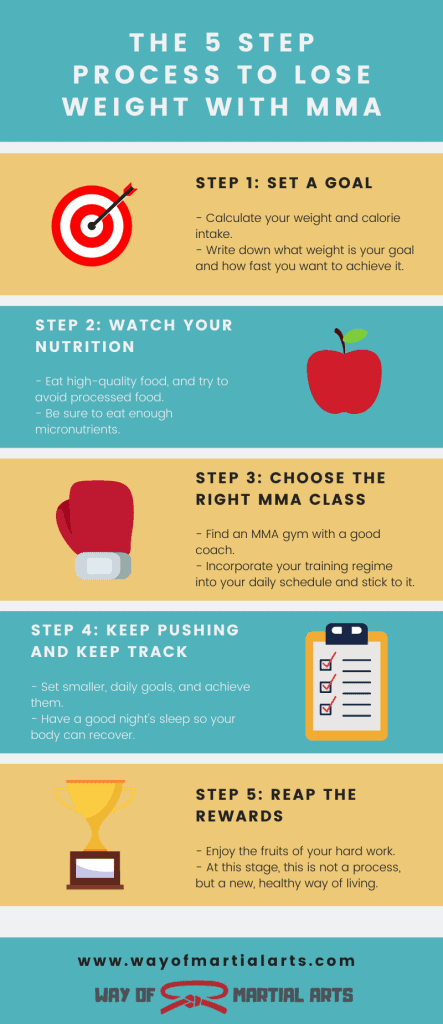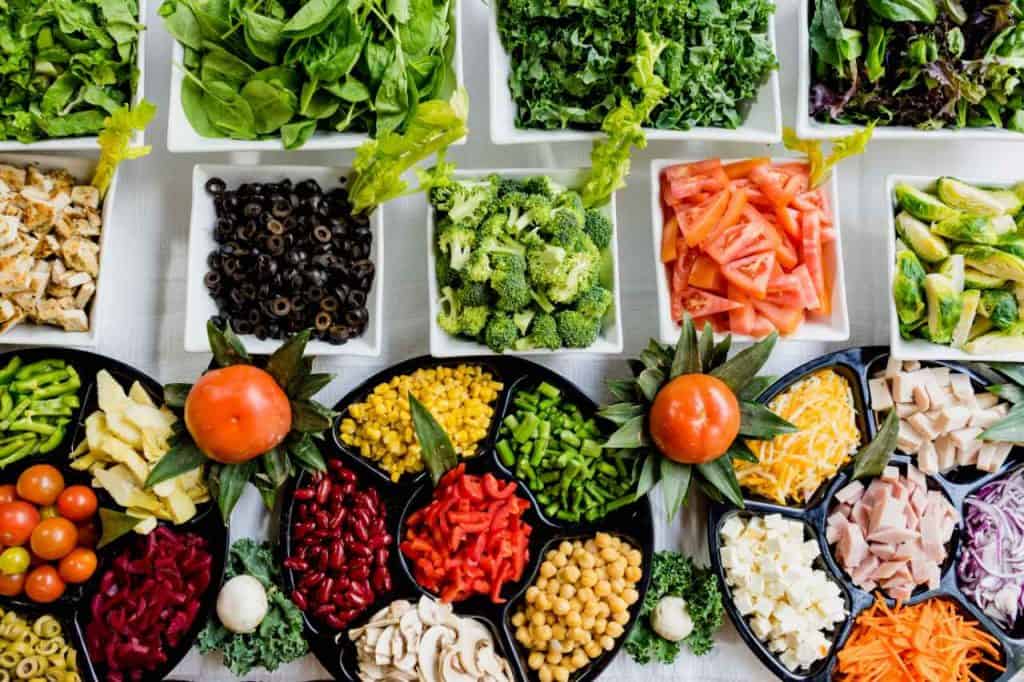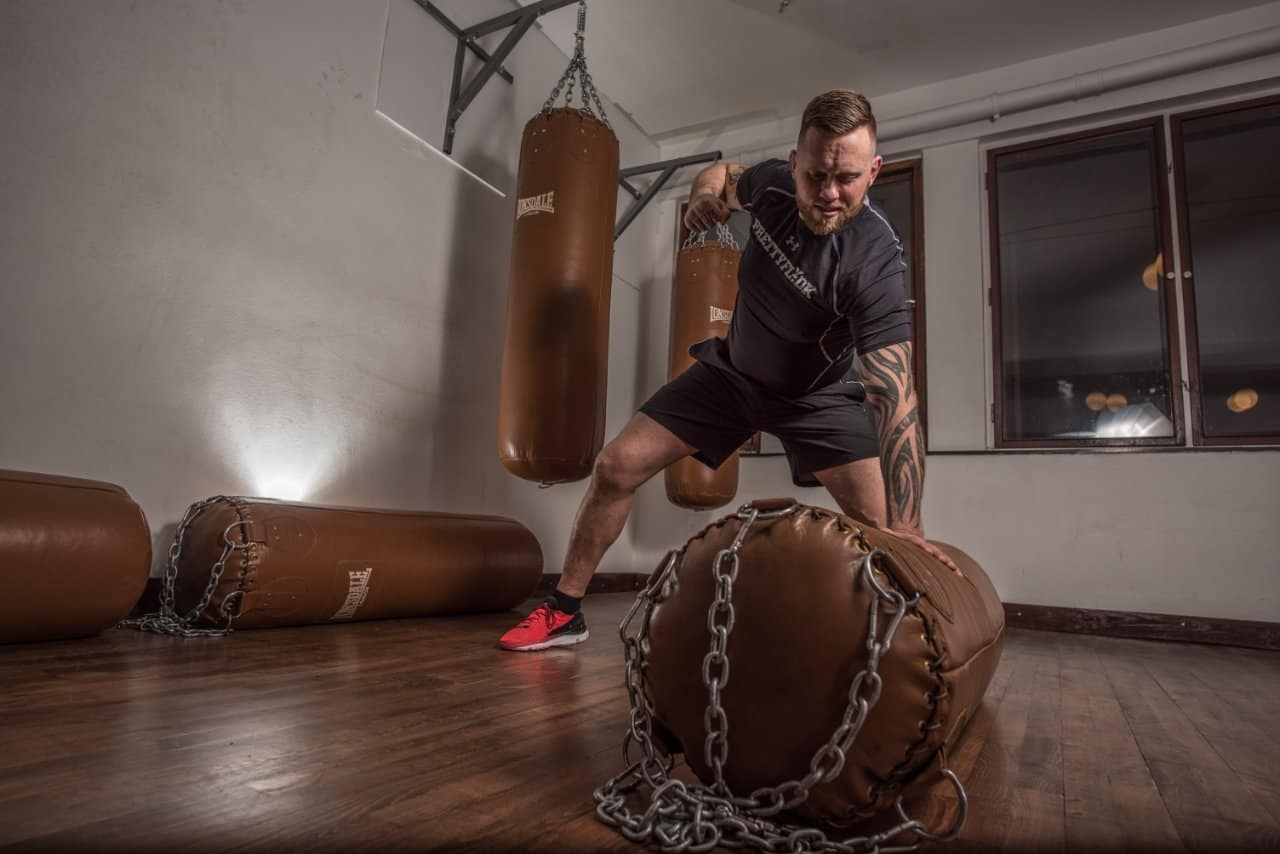Recent years, MMA has been the fastest growing sport worldwide. It consists of striking and grappling, mixing the broad array of different martial arts, and summing it up into the one. When you see MMA fighters or training online, there is no chance that in a matter of seconds the idea of how hard MMA is, doesn’t come to your mind. Seeking how challenging it is, you have probably asked yourself is MMA good for weight loss, and is it the right fit for you. In the following article. we will go through five steps you should follow if you want to lose weight with MMA.
Five steps you should follow to lose weight with MMA:
- Set a goal.
- Watch your nutrition.
- Choose the right MMA training regime.
- Keep pushing and keep track of your progress.
- Enjoy the rewards of your hard work and keep going!

That’s it. It is that simple. Five easy steps to follow. Just kidding, the journey to successful weight loss is not easy. It is hard, it is long, and you should be ready for that. But if you stick to those five steps we mentioned, the rewards will be incredible. Not just physically, but psychically as well. Not only will your body transform, but the mind as well. You will be completely different person. Ready to conquer all challenges ahead of you.
So, now that you are pumped up and ready for the beginning of your journey, let’s give you some basic knowledge you have to know about losing weight, and then, we will jump to explaining the five steps in the detail.
How to Lose Weight? The Scientific Way
In order to successfully lose weight, you should know the right way to approach it. One might think that losing weight is associated with doing 1000 crunches and 500 push-ups per day, but that is not the right way to go.
There is a lot of theoretical stuff proven by science that you should be familiar with. When you are acquainted with the basics of losing weight, and you know what you are doing, the journey to your goal will be significantly easier. And we are here to help you.
First, and the most important thing you must know is that when someone says that they want to lose weight, they usually mean they want to get lean, lose fat and maybe build some muscle in the process. Getting lean and losing fat is a long journey.
On the other hand, you might find some articles that say “MMA fighters losing 20 pounds in two days! Learn how!”. You might expect us to say that that isn’t true, but actually it is. One can lose a tremendous amount of pounds in a matter of hours due to dehydration.
BUT, it is incredibly dangerous and absolutely no point in doing that. It can lead to major longstanding health issues, even death. Why do MMA fighters do it? Because before a fight, they have to hit a specific pound limit to be able to compete the next day. In short, they get rid of water in their body, and the next day, the water comes back, resulting in a 20-30 pound difference in just a day or two.
So, they do it the day before, and the next day, they will be inside the cage with 20 pounds more. Nevertheless, we just had to mention this. Remember, if you stumble upon such techniques, stay away from it. It is very dangerous and absolutely no point in doing it.
Let’s get back to the right way of losing weight, through losing fat inside your body. As already said, it is a long process. But why?
To best explain it, first let’s mention calories. What is a calorie? A calorie is a unit of energy. All types of food consist of energy. When we eat, we consume calories. Those same calories are used in three ways:
- for correct work of metabolism
- for moving (any type of activity; walking, running, speaking, playing video games…)
- the rest of unused calories are stored as fat, thus, we gain weight
So, how do calories come into play? Take a look at the third point. Surplus of calories is stored as fat, and that fat results in more weight, respectively more pounds on the scale. In fact, the surplus of 3,500 calories is stored as one pound of body fat.
What exactly does calorie surplus mean? Calorie surplus means that we are consuming more calories than we burn (through body functions and activity). That results in storing fat in our body and gaining weight.
On the other hand, a calorie deficit is a state when a person consumes fewer calories than they burn. That results in weight loss.
As already said, the surplus of 3,500 calories results in one pound of body fat gain. A deficit of 3,500 calories results in one pound of weight loss. In kilos, that is approximately 7,800 calories for one kilo of body fat.
It is simple as that. Basics of physics. There is no secret sauce, no magic food or training plans. That’s how it works. If you eat more than you should, you gain weight, if you eat less, you lose weight.
Now. you might be asking yourself what exactly caloric surplus and deficit refer to. It refers to caloric maintenance. Calorie maintenance is the number of calories you need per day to maintain your current weight, respectively not gaining nor losing pounds on the scale. For a “normal” person it is around 2,000 and 2,500 calories, but it vastly depends on a person’s level of activity, age, gender, genetics, etc.
To get a better understanding of the concepts mentioned above, let’s give three examples. For all three cases, John has caloric maintenance of 2,000 calories per day. Meaning, if he consumes 2,000 calories a day, he will remain the same weight. If he consumes more than 2,000 calories a day, he will gain weight. On the other hand, if John consumes less than 2,000 calories a day, he will lose weight. John weights 150 pounds (68,2 kg).
- Over the course of the next 10 days, John is eating 2,000 calories a day. Meaning, he consumes the right amount of calories for his weight to remain the same. After 10 days, John will weight 150 pounds (68.2 kg).
- Over the course of the next 10 days, John is eating 3,000 calories a day. Meaning, each day, he has a surplus of 1,000 calories. 10 days equal to a surplus of 10,000 calories which equals 2.8 pounds (1.3 kg). After 10 days, John will weight 152.8 pounds (69.5 kg).
- Over the course of the next 10 days, John is eating 1,500 calories a day. Meaning, each day, he has a deficit of 500 calories. 10 days equal to the deficit of 5,000 calories which equals 1.4 pounds (0.7 kg). After 10 days, John will weight 148.6 pounds (67.5 kg).
That’s it. Simple math. All of the above is perfectly summarized in the table below.
| Calorie status | Calorie amount | Weight change |
| Caloric surplus | Calories consumed > calories burned | Weight gain |
| Caloric maintenance | Calories consumed = calories burned | Weight remains the same |
| Caloric deficit | Calories consumed < calories burned | Weight loss |
Is MMA Good for Losing Weight?
So, how does MMA comes into play when talking about losing weight? Above, we have talked about calorie consumption and how is that equal to the amount of food we eat. But what about the calories that we burn? We have said that our body uses calories for its functionality, and for our activity.
Activity means every single movement we do. It can be running, walking, writing, even cooking or watching TV. Every single piece of activity burns calories. Of course, the amount we burn depends on that activity. It is obvious that running, for example, burns a lot more calories than just sitting and playing videogames.
To be in a caloric deficit, you have to burn more calories than you consume. As already stated, activities do burn extra calories. That is also true with doing MMA. MMA training is a grueling type of exercise that burns a lot of calories.
But, it is almost impossible to say how much calories exactly does one hour of MMA training burns. It depends on your weight, your genetics, how hard do you go, which specific exercise do you do, etc. Just for an example (have in mind that given number can vary a lot from person to person), livestrong.com stated in one of their articles that 160 pounds (72.7 kg) can burn up to 500 calories per hour of MMA workout.
So, incorporating MMA workout into your weight loss regime is a very good idea. On top of helping you with losing weight, joining an MMA class will benefit you in other areas as well (check out the article we wrote about 15 reasons why MMA is good for you).
Nonetheless, now that you are familiar with the basics of losing weight, let’s go through our five-step process of incorporating MMA workouts to lose weight.

Step 1 of Losing Weight with MMA: Set a Goal
The most important thing when starting with your weight loss journey is to evaluate where are you today and where do you want to be in a given period of time. You simply have to set a goal. It might sound a little bit crazy, but write your goal down on the piece of paper or on your mobile device. Be sure to check it out each day and to stick to it.
How exactly to do it? The first thing you have to see is your current body weight. You can just step on a scale and save the number. But, that isn’t exactly the right way. Why? Because your weight can change drastically in the course of a few hours. For example, you might just have a big meal hours before, or you drank a lot of water. etc.
How to do it properly? Weight yourself for three days in a row, first thing in a morning (before you eat or drink anything). Save your weight, and calculate the average. That number is far more precise. Here is an example.
| Morning 1 | Morning 2 | Morning 3 | Average weight |
| 150 pounds (68.1 kg) | 148 pounds (67.3 kg) | 151 pounds (68.6 kg) | 149.7 pounds (68 kg) |
Now that you know your weight, comes the process of calculating your caloric consumption. How is that done? Well, it takes some time, a period of two weeks is fine. For the next two weeks, you have to watch your caloric intake. Every single day, write down how many calories have you eaten.
After those two weeks, repeat your weighing. For three mornings in a row, weight yourself, and calculate your average weight after two weeks. Ok, you might be asking yourself where are we going with this, and does this make any sense? Let’s move on with our example.
As stated above, calculated weight at the start of two weeks period is 149.7 pounds (68 kg). Your caloric consumption for the next two weeks is give in a table below:
| Start | 149.7 pounds (68 kg) |
| Day 1 | 2500 calories |
| Day 2 | 2800 calories |
| Day 3 | 2700 calories |
| Day 4 | 2600 calories |
| Day 5 | 2400 calories |
| Day 6 | 2500 calories |
| Day 7 | 2400 calories |
| Day 8 | 2800 calories |
| Day 9 | 2300 calories |
| Day 10 | 2500 calories |
| Day 11 | 2600 calories |
| Day 12 | 2500 calories |
| Day 13 | 2700 calories |
| Day 14 | 2600 calories |
| End | 151.5 pounds (69.3 kg) |
So, after two weeks, you have gained 151.5 – 149.7 = 1.8 pounds (0.8 kg). Ok, now, let’s remember what we have said about pounds and calories. One pound of gained body mass equals to a caloric surplus of 3,500 calories.
In two weeks, you have gained 1.8 pounds. That means that in that period you have consumed 3,500 x 1.8 = 6,300 calories more than you burn.
Over the two weeks, you have consumed 35,900 calories. As stated, 6,300 is surplus. So, if you wanted to remain the same weight, you should have consumed 35,900 – 6,300 = 29,600 calories over the two weeks to maintain your weight.
That is 29,600 / 14 = 2,114 calories per day to maintain the weight. That’s it. Now that you know your number of calories to maintain the weight, it is easy to move on.
To recap, for purpose of illustration, your weight is now 151.5 pounds (69.3 kg) and your calorie intake for maintenance is 2,114 calories a day.
We have said that you must set a goal. Let’s say, that in the next two months you want to lose 5 pounds (2.3 kg).
As we already know if you want to lose 5 pounds (2.3 kg) over a period of two months, you have to have a total caloric deficit of 5 x 3,500 = 17,500 calories.
That is a total of two months. Daily, on average, you have to be in a caloric deficit of 17,500 / 60 = 292 calories.
So, to stick to your goal, over the next two months, you have to consume 2,114 (your caloric maintenance) – 292 (deficit needed) = 1,822 calories.
If you consume 1,822 calories per day for the next two months, you will lose that 5 pounds (2.3 kg).
Okay, you might be thinking that this is complicated. But it isn’t. Be sure to read these examples one more time and see how actually easy it is. One more good thing about this first step? It is BY FAR THE MOST IMPORTANT ONE. If you know how to calculate calories, and what underlies in losing weight, everything else is easy if you stick to it.
Being knowledgable about calories, and their connection to weight change is crucial. So, let’s see step number two.
Step 2 of Losing Weight with MMA: Watch Your Nutrition
Now that we know that change in weight depends solely on your caloric intake, what does “Watch your nutrition” exactly means. Does that mean that if I stick to my calorie goal, I can eat any food I want? No, not exactly.
Although, the number of calories is the most important factor when it comes to weight loss, there are few more things we have to consider. The number one is health.
On top of watching how many calories you eat, you have to watch for your health, thus, eat high-quality food that is rich in vitamins, minerals, and other nutrients important for body functions.
Macronutrients
All food consists of three different macronutrients. Protein, carbs, and fat. All three of those are extremely important.
Proteins are used for building and preserving your muscle. Carbs are here to give you energy for your workouts and everyday tasks. And fats are extremely important for your internal body functions, hormones, and brain health.
When you hear someone say that carbs and fats are bad, that is one of the dumbest things you can hear. It is so far from the truth that it is almost dangerous to say something like that. If you would stop eating carbs or fat, you would soon become ill and your body would stop functioning correctly.
But, there are some differences in the type of carbs and fat you eat. Carbs and fat that we can find in fast food, processed food are actually pretty unhealthy for your body. Nevertheless, that is not the type of food you want to consume (from time to time it is perfectly okay, but not on a daily basis). So let’s see some good examples of food by macronutrients you could eat.
- Protein-rich food: all sorts of meat (but not the processed ones), fish, eggs, dairy products, protein snacks
- Carb rich food: potatoes, rice, oats, all sorts of different whole grains and beans
- Healthy fat-rich food: all sorts of nuts (peanuts, almonds, walnuts, …), healthy unprocessed oils (olive and coconut, for example, not sunflower)
Micronutrients
Proteins, carbs, and fat are the macronutrients found in food. On the other hand, there are also micronutrients that are extremely important for overall health and body functions. Those consist of vitamins and minerals.
Vitamins A, C, and K can be found in all fruits and vegetables. Vitamin B can be found meat, egg, and dairy products. Vitamin D is mainly gained from exposure to Sun and from milk and fish oil.
Some of the important minerals you have to ingest are iron, copper, zinc, calcium, potassium, magnesium. They are extremely important for your body to function correctly and can be mainly found in whole grains, meat, dairy products, healthy oils.
Micronutrients are extremely important for each individual to be knowledgeable about, but as the topic of our article is “Weight Loss with MMA”, let’s get back to it. If you are interested, and you should be, check out this article from Healthline about micronutrients.
Now, let’s finally see how MMA comes in play when losing weight.

Step 3 of Losing Weight with MMA: Choose the Right Class for You
Following steps 1 and 2, you know everything about setting your goals, measuring your weight and calorie intake, and what type of food you should eat. The time has come to talk about MMA training.
MMA is a combat sport that consists of striking and grappling aspects. Striking aspects have a variety of different punches and kicks, and grappling aspects are composed of wrestling and submission attempts. Clinching also comes in play.
All of those aspects are very different, but also consume a lot of energy.
This step is very broad, and there are a lot of things to talk about when choosing your MMA gym, which class you should join, how to choose the right gym, which equipment you need. So, we have decided to write a completely separate guide to choosing an MMA class. Be sure to read our article on MMA training in detail.
Although all given steps, tricks, and suggestions are given in the article above, let’s just summarize a few important things.
As we have said earlier, in order to be in a caloric deficit you either have to lower your caloric intake or increase how much calories you burn. To remind ourselves, on average, we can say that an hour of MMA class burns up to 500 calories. If you incorporate that training three times a week. It is additional 1,500 calories to the total amount of calories you have burned. It will surely help you a lot with losing weight.
But remember, although going to MMA classes is a very nice additional tool to help you with losing weight, the amount of calories you put in you is still the number one. You simply can’t burn that many calories you can eat. So, follow your diet, and add some MMA training to it to help you even more with losing weight.
We are ready for step 4, but before we continue, be sure to check the article we have linked for you above for step 3 in the detail.
Step 4 of Losing Weight with MMA: Keep Pushing and Keep Track
Up until now, you have set everything you need. You have your detailed plan about how much you eat, you found an MMA gym for you and have chosen a class.
You now know everything there is. But, here comes the crucial moment. It is dedication. If you want the results, you must stick to the plan. Just write down your complete plan and schedule. And be sure to stick to it. Here we will give you a few tips to help you with process.
Tip #1: The most important tip is to enjoy the process. This is not punishment, nor restrictions. This is a way to a new, and healthy lifestyle. A way to transform your body and mind.
Tip #2: Try to stick to your calorie intake. If it is 2,000 calories per day, eat 2,000 calories per day. But, if your friend has a birthday, don’t feel bad to eat 500 calories more for that day. If you eat 2,500 that day, just eat 1,900 for the next five days, and your total intake will remain the same. Remember, enjoy the process, don’t restrict yourself.
Tip #3: Yes, you should eat healthy and unprocessed food. But, as said in step 2, there is nothing wrong with eating a pizza or a burger once a week.
Tip #4: Don’t push yourself too much when training. Follow your instructor and be sure to have a proper warm-up and stretch after.
Tip #5: Get a night of good sleep. Sleep is one of the most important things for a healthy body and life. You should try to aim for eight hours a day of sleep.
Tip #6: When you begin, write down how much you except to weight after every two months. After those two months pass by, weight in again and check how are you doing. If you are sticking to caloric intake, you should hit your excepted weight.
Step 5 of Losing Weight with MMA: Reap the Rewards
Six months have gone by. You have lost let’s say 30 pounds. Nine months have gone by. You might have lost 10 pounds more. You are becoming leaner. You are starting to see that you might be gaining some muscle. You are feeling better. You are full of energy. You are not succeeding just in classes, but also in life in general. You are a completely different person. Full of energy, confidence, determination.
Alongside choosing the right MMA training regime, investing in the right gear, like a top Heavy bag stand for heavy bag and speed bag, as featured in article [2], is essential for building the striking and cardiovascular endurance necessary to succeed in your weight loss journey; let these high-quality stands empower you to unleash your fighting spirit and become an unstoppable force.
Keep going, and keep pushing. This is not a year-long journey. This is a lifelong journey. Journey to not just losing weight, but becoming a better person in general. Trust us, if you stick to these steps, you will soon reap the rewards. Until next time!
If you have any other questions about MMA in general, be sure to check out all the articles we wrote about MMA. You might find something useful and interesting!

